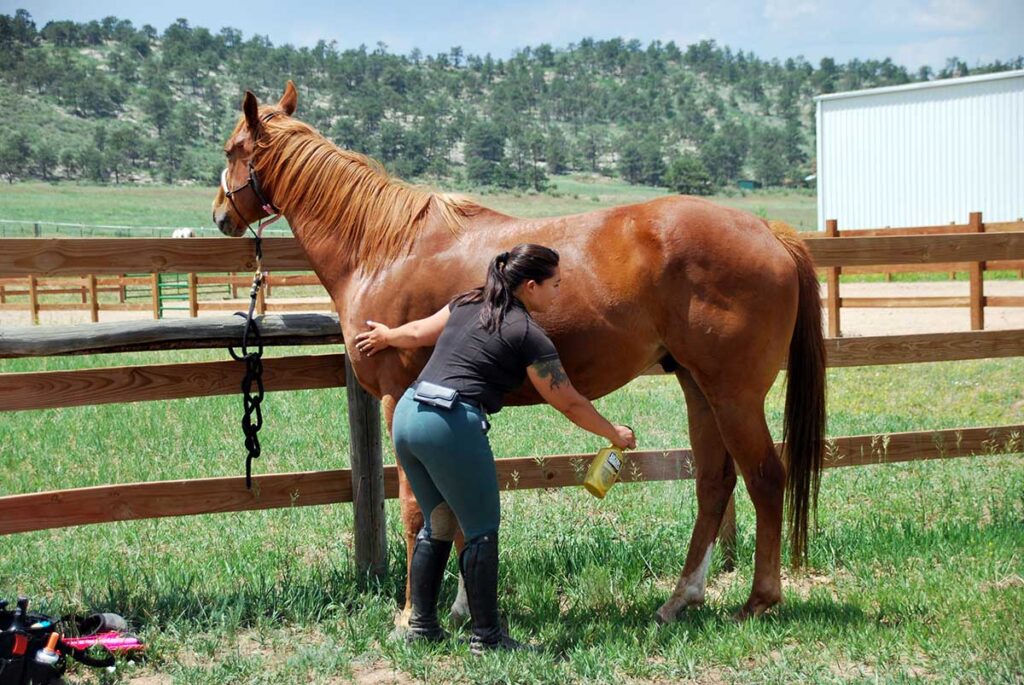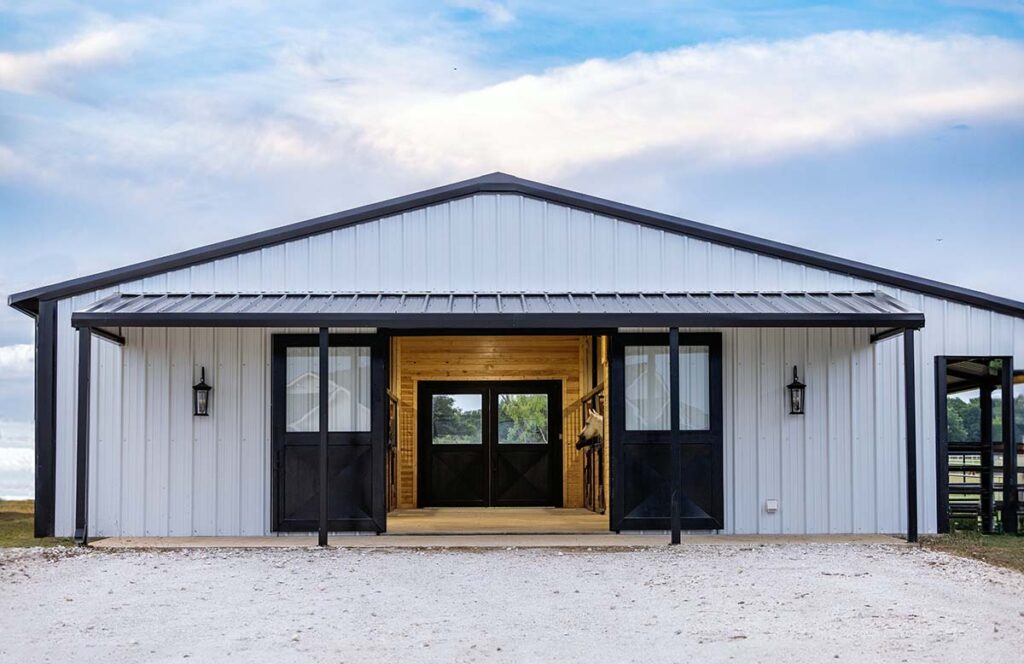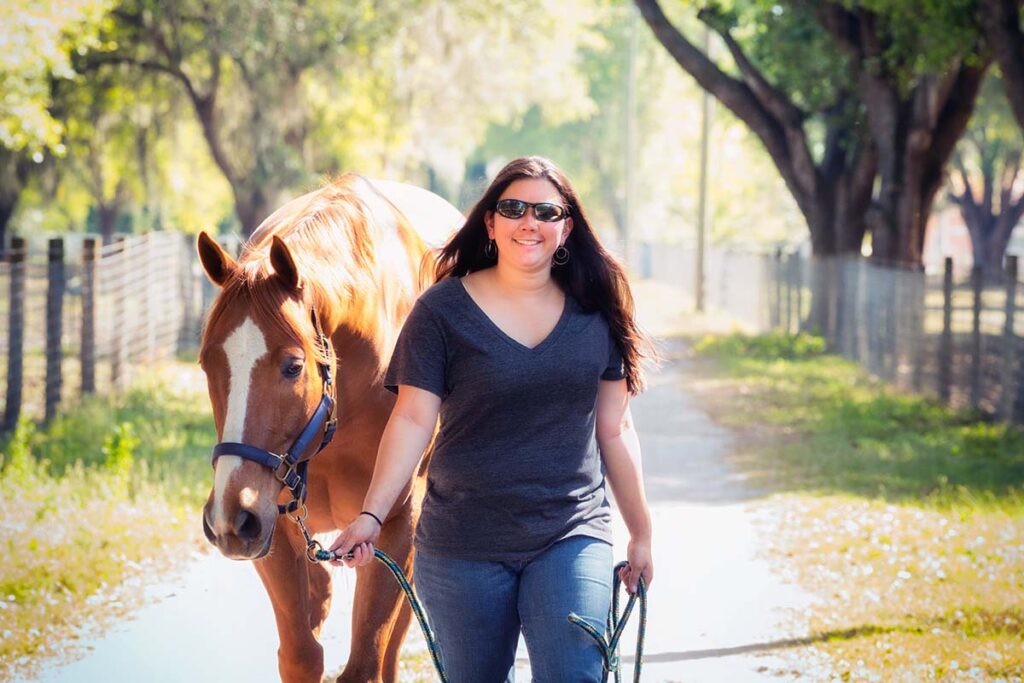Regular hoof trimming—and shoeing, if necessary—is a must if you own horses. But first-time horse owners, or those moving to a new area, might not know where to start when it comes to finding a reputable farrier to care for their horses’ feet. We’ll discuss some of the criteria that set the top farriers apart from the pack. We’ll also give you tips on how to find a farrier whose experience suits your horse and your equestrian activities.
Find a certified farrier.
Farriers don’t have to earn a specialized degree to be permitted to practice their craft. As a profession, farriery is more like riding instruction. Voluntary coursework and certification are available (and desirable), but almost anyone can “hang out a shingle” and advertise for business. Competent farriery requires extensive knowledge and training. You are strongly advised to seek a farrier who has earned an American Farrier’s Association (AFA) certification. Through its more than 70 chapters, the AFA administers a rigorous program of education and testing, open to AFA members. It offers the following classifications and levels of certification:
- AFA Interns have successfully completed an entry-level written examination on equine lower-limb anatomy, physiology (characteristics and functions), and pathology (disorders); conformation, gaits, and movement problems; and types and sizes of American horseshoes and horseshoe nails. The title “intern” is a classification only; AFA Interns are not certified farriers.
- AFA Certified Farriers (CFs) have at least one year of farriery experience. To earn CF certification, a candidate must pass a more detailed written examination on the above subjects and take a two-part practical exam on shoeing and shoe display (making a variety of “regular” and therapeutic horseshoes and traction devices). All practical exams are administered and scored by AFA-approved examiners or Approved Testers.
- AFA Certified Journeyman Farriers (CJFs) have at least two years of experience and must have earned CF status. To earn CJF certification, the highest level offered by the AFA, a farrier must pass a third, even more advanced, written test and a second practical examination. In the CJF practical exam, candidates must shoe four feet with handmade shoes and must make a bar shoe to exacting specifications. After they earn CJF certification, farriers can pursue two additional AFA “specialty” endorsements — Therapeutic and Educator.
The AFA maintains a database of certified farriers. You can also search the International Association of Professional Farriers directory.
Look for a farrier experienced in your breed or riding discipline.

While all AFA-certified farriers have demonstrated competency in evaluating and shoeing a range of horses, you might want to look for one who’s experienced in shoeing for your own equestrian specialty, particularly if you plan to pursue your discipline competitively. A farrier who shoes mostly jumpers and dressage horses, for instance, might not be as well acquainted with the stresses of and shoeing requirements for reining or cutting. And one whose clientele consists mostly of Quarter Horses might not be accustomed to working with a five-gaited Saddlebred’s long hooves and special footwear.
If you board your horse at a specialized training facility or a barn whose clientele consists mostly of horses and riders in your chosen breed or discipline, ask the barn manager, trainer, or other horse owners for the name of their regular farrier. Chances are he or she is among the best in the area. If you keep your horse at home and don’t have fellow boarders or a manager to consult, try telephoning a well-known area facility that specializes in your area of equestrian interest. Ask to speak with the stable manager, then ask that person if he or she can recommend a reputable farrier who has experience shoeing for your discipline. A savvy stable manager, recognizing that you’re a potential client, will be happy to help.
If your horse has a foot condition, find a farrier with experience managing it.
If you know your horse requires special shoeing — if he has navicular problems, for example, or suffers from chronic laminitis — you’ll want to find a farrier with experience trimming and shoeing to minimize these conditions. Your veterinarian can be a valuable reference in such cases, as can area veterinary schools and large-animal hospitals. A farrier who’s earned the AFA’s Therapeutic Specialty Endorsement also would be a good bet.
Even if your horse is in perfect health, the day might come when you’ll be glad to have a farrier who is willing to work as a partner with your veterinarian (and vice versa). Most reputable farriers and veterinarians respect one another’s specialized knowledge and skills. They’re open to discussion on how to keep your horse’s feet and legs as sound as possible.
Make prospecting calls and ask questions.
After you’ve obtained the name and number of a likely farrier, call and briefly describe your horse, the type of riding you do, and any known hoof conditions or lamenesses. Ask whether he or she is accepting new clients. A good professional will return your call promptly, answer your questions, and provide references if you desire.
Ask questions about pricing, payment, emergency visits (such as lost shoe replacement), and any other concerns you might have before you engage a farrier’s services. Feel free to ask various farriers what they charge for new shoes, resets, trims, and special shoeings. Be aware that the better farriers probably command higher fees. Some farriers expect to get paid at the time of the shoeing; others bill their clients.
Schedule an appointment.

If the farrier makes regularly scheduled visits to your boarding barn, you might need to do nothing other than have your horse’s name placed on the list and provide the date of his last shoeing and the name of your regular veterinarian. If your barn will be a new stop for the farrier, ask how he or she schedules regular trimmings and shoeings. Some farriers don’t come out until you call to make an appointment, so ask how the farrier operates. If you must call each time your horse needs a trim, find out how far in advance you should call to secure a timely appointment.
Even if you keep your horse at a full-care facility, it’s best if you can be present for his initial appointment with a new farrier. Establish yourself as a must-keep client by having your horse ready at the designated time. Don’t wait until the truck pulls in the driveway to wander out to the field to catch Dobbin. (Does Dobbin stand quietly and lift his feet obediently? If he doesn’t, give him a refresher course before the farrier arrives. Enlist the help of a qualified trainer if needed.)
Provide your farrier with a dry, covered, relatively dust-free, well-lit, uncluttered space in which to work. Easy access to an electrical outlet and to running water are pluses. A fan in hot weather and a door to keep out winter’s chill are also much appreciated.
Before the farrier begins working on your horse for the first time, he or she should take a few minutes to examine the condition of your horse’s feet and legs as well as the type and wear patterns of existing shoes. Next, you should be asked to walk and jog your horse in a straight line so the farrier can observe his movement. These getting-to-know-you steps are of critical importance in trimming and shoeing your horse correctly.
If your farrier tells you something you don’t understand or you have a question about a recommendation or a procedure, don’t hesitate to ask. A good farrier welcomes clients’ questions and is happy to explain terminology, observations, and techniques.
Note the way your farrier works around your horse. Farriers might not themselves be riders, but they should at least appear to like horses and enjoy working with them. Patience and kind words are always preferable to yelling and hitting, especially if your horse is nervous or fearful. Unnecessary roughness is not acceptable.
Take-Home Message
A good farrier leaves your horse feeling and moving better than before. Even the best farrier can “quick” a horse — drive a nail close to or into the sensitive hoof tissues — on rare occasions. But, unless he’s lame to begin with, your horse shouldn’t habitually be sore after he’s trimmed and shod. Take the time to find a farrier that suits your horse. Then strive to be the kind of client with whom it’s a pleasure to do business. Your horse will thank you for it.
Related Reading:
- How To Communicate With Your Horse’s Farrier
- Farrier Visit 101: How To Prepare and Handle Your Horse
- Horse Hoof Care Schedules, Supplies, and Best Practices
Are you enjoying this content? Sign up for My New Horse’s FREE newsletter to get the latest horse owner info and fun facts delivered straight to your inbox!








